For the past month, the weather in the Rancho has been either very mild or colder than a witch’s bazooms depending on whether you ask me or the ever-chilly Alpha Japanese Female (AJF).
In Southern California, this weather pattern is called “May Gray” which often segues into June Gloom and, sometime, No Sky July and Fogust.
In any case, the cool, cloudy mornings and higher humidity have been ideal for our garden of Japanese vegetables.
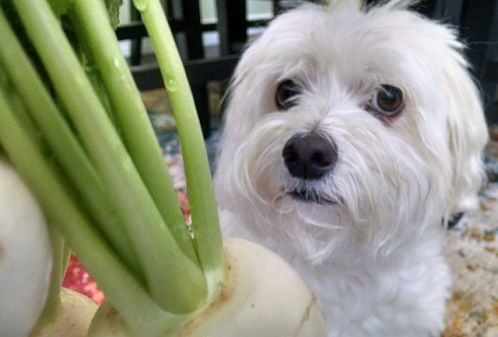
“I feel intimidated by these strange vegetables.”
In particular, our kabu crop has done wonderfully. In Japan, these white turnips are popular winter vegetables but we’ve found that our crop develops best when planted the first week of April for an early to mid-June maturation. Kabu loves it when the daytime temperatures stay between 60°-80°F, (16° – 27°C).
We start with seeds that we buy from the Kitazawa Seed Company in Oakland, California. Kitazawa is a superb source for Asian vegetable seeds, especially those that are hard to find.
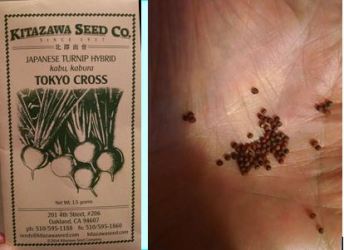
We’ve had great success with all the seeds we’ve purchased from this company!
One packet of kabu seeds sets us back about $3.95 and contains enough of the tiny seeds for the Spring season at our rate of consumption.
While kabu is dubbed a “Japanese white turnip”, these globular morsels are unlike their Western counterparts.
They have a sweeter taste, a hint of nuttiness and a fresh earthy flavor and can be gobbled raw or cooked.
When cooked, kabu soften and exude a slight spiciness, something like a cross between a radish and a turnip. The bright green leaves are also edible .
These turnips are good for you, too. The roots are high in vitamin C and iron; the leaves are high in fiber, vitamin A, and calcium.
Kabu typically range in size from a golfball to a baseball or perhaps a cricketball if you live in a country that understands that incomprehensible and never-ending game. There are outliers, of course, and some types of kabu can grow to near-basketball size.
We usually harvest when the globes are about 2-3″ in diameter.
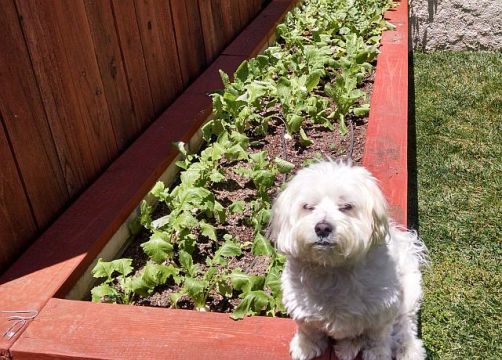
We plant our kabu in a raised planter, one of several that we maintain for different vegetables. If placed in the ground it’s a constant fight against insects, especially cabbage worms, slugs and snails, oh my! Note guard dog earning his keep and protecting the crop.
No one knows exactly how kabu got to Japan. Turnips originated in India and gradually spread around the world and diversified. Like many non-native vegetables, kabu likely came to the Land of the Rising Sun from China. Records indicate that kabu has been widely grown and consumed in Japan since the 7th century.
Kabu is frequently boiled and served in soups or as an ingredient in a Japanese hot pot. You can also slice them into thin discs and toss in fresh salads, or steam or roast them with other vegetables/meat, or add them into stir-fries. With their mild and juicy flavor, they make a delicious side dish to meat dishes like roast fish and savory grilled meat or with any vegetarian meal.
The AJF loves to make nukazuke which are pickles made by burying the veggies and fermenting in rice bran which is first mixed in a crock with salt, kombu seaweed, and water. Beer is added to the bran mix (my contribution) to launch the lactic acid needed for fermentation. The resultant mash, called nukamiso or nukadoko, has a consistency comparable to wet sand and a pungent fragrance, which means it stinks.
The AJF stores her nukazuke crock in my beer fridge in the garage. The things I do for that woman. I am a saint.
INTERMEZZO
Stupid Dog Joke
I was walking my pup along the river in Germany when the doggo suddenly fell in! Immediately, a German man jumped in the water and rescued my dog. When he brought him onshore the German man closely examined the pup and recommended a hot bath and lots of fluids to help the dog recover. I thanked him profusely and asked, “Are you a vet?” He replied, as only the Germans can, “Vet? Vet? I am frickin soaked.”
Snorf.
BACK TO OUR KABU DISCUSSION
Our kabu season will last through June then the summer heat will terminate chances of successfully growing more of these tasty treats. I have already started a second batch of seedlings, hopefully to squeeze two crops from our short growing season. When gone, we will replace the kabu with Japanese eggplants which love the heat and also produce excellent pickles as well as being all-around versatile veggies.
The white turnip is not yet common in many areas of the US. It has started to show up at farmers’ markets and on the coasts. Kabu may become a trendy vegetable – I saw some recently at a Whole Foods store. Ai yai yai, the price!
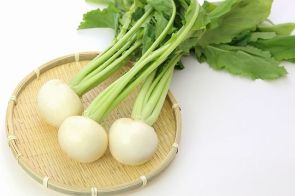
Trimmed and ready for slicing!
In Japan, the kabu has cultural significance. The Festival of Seven Herbs is a long-standing Japanese custom of eating a rice porridge made of seven herbs and veggies (including kabu) on January 7th.
The seventh of the first month has been an important Japanese festival since ancient times.
This ancient custom is said to bring longevity and health, and ward off evil. Maybe because a touch of greenery in one’s diet in mid-winter could be the difference between sickness and health.
Surprisingly, turnips are OK for dogs to eat. Modern Dog Magazine (yes, there is such a publication) says, “Turnips can be a great treat for your dog. Serve them dehydrated, baked, mashed, or raw.”
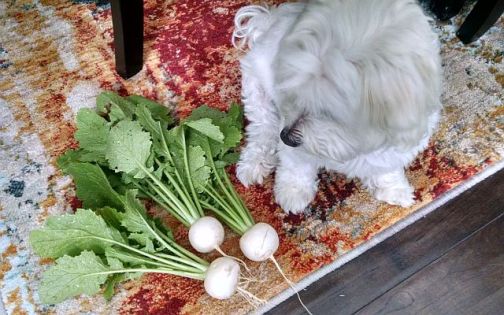
Malt provided for scale. He wonders why we waste time on things he doesn’t like to eat. “Grow some chicken jerky, Dad.”
Max is obviously not interested in kabu. It’s not on his doggie diet plan and, based on his face when presented with a kabu, he would be happy to never see one again.
Analogy of the Fluff when presented with a turnip:
Come to think of it, with Max’s fat little belly and white fur, I think I’ll start calling him “Kabu.”
One is a doggie
One is a kabu
One can be salty
The other is Malt-y.
PS: Max didn’t appreciate the “fat belly” comment. His remark, “Sometimes you really put the stew in stupid, Dad.”
Categories: The Dog From Rancho Cucaracha

I think little Max needs sunglasses and a little vest that says ‘Guard Dog.” You do have a Beware of Dog sign, right?
LikeLiked by 1 person
We used to have a Beware! sign on the gate but I noticed it’s missing. I suspect Max was afraid the neighborhood pups would take it as a challenge.
LikeLiked by 1 person
Damn! Our rainy season temperatures might be right…but no time to get the seeds sent to an American friend who is coming down this week.
European turnips don’t do well here…so while our haggis can be accompanied by tatties, it lacks the bashed neeps.
You have a good guard dog there…grow him some chicken jerky.
LikeLiked by 1 person
Say the word and I’ll put a packet in the mail!
LikeLike
The word!
But given the maniacs in the customs service it would end up in their depot for a month before notifying me…then I would trek down there, pay them for storage then have the packet opened in front of me and confiscated. So far they have not imposed a confiscation fee….
LikeLiked by 1 person
Kitazawa has a website at kitazawaseed.com where you can browse their various vegetable seed offerings and they have an excellent and interesting 48 page catalog that you can request online. I think they ship anywhere if ever you want to try your luck with Customs. The catalog offers more info than you’ll ever need; for example, full descriptions and details of 14 different Japanese eggplant varieties alone.
LikeLiked by 1 person
Right…that sounds ideal. Many thanks!
LikeLiked by 1 person
Fair’s fair…we are currently deluged with vast quantities of Costa Rica – grown pineapples which are an abomination to a Hawaii boy like me. But tasty and cheap uh, or so I’m told. (Cough)
LikeLiked by 1 person
They were all over the English supermarkets when I visited my mother in March…as were orchids. Now, does Hawaii do the white fleshed pineapple?
LikeLiked by 1 person
Nope. As far as I know ( which isn’t very far) Hawaii deals in gold pines only!
LikeLiked by 1 person
I hope Max doesn’t get too Vet this week, Tom. Thanks for sharing.
LikeLiked by 1 person
Ha! As I read your post I was getting ready to give that Kabu Dog a bath so, yes, we both will be getting wery, wery vet soon.
LikeLike
Have you thought about letting one plant go to seed and then you’ll be ready for next year?
LikeLiked by 1 person
Not sure, KIsmet, but I think these are hybrid rather than heirloom seeds so I am not sure if they will propagate in subsequent years. Nowadays Monsanto holds a lot of the seed patents and they are tough on protecting their seed inventories. But never checked to be sure and now you’ve made me curious so I’ll look into it.
LikeLike
If you find some heirloom-I assume that the Japanese have been doing this for years,- you’ll know that you’re not getting “frankenfood”.
LikeLiked by 1 person
I did a search on “heirloom kabu seeds”-yes, you can order them.
LikeLiked by 1 person
Thanks for the tip! Now I may have to grow bird seed. Snorf.
LikeLike
Bwahaha! As German born, the joke seriously had me cracking up as one who is one, can appreciate its subtlety. From our vantage point, Max seems unimpressed with the nutritional value of kabu. Sam would probably look at me with the same air of distain and then sit with his back to me. Elsa would eat it in a nano-second. Enjoy the cooler temps, I’ll be green with envy when it’s back in the 90’s next week.⛱
LikeLiked by 1 person
The cooler temps have gone the way of the buffalo. It’s 92 today and the low for the next10 days is 84. The kabu will just have to tough it out.
LikeLiked by 1 person
Yikes! Maybe Max can cast a Malt shadow to protect the precious kabu for his mum.
LikeLiked by 1 person
It would be a big shadow! The Maltster is a little porky right now.
LikeLiked by 1 person
All the better for the Laub I should think.
LikeLiked by 1 person
1 person Reply, thanks so much for the post.Really thank you! Great.helpwithmath
LikeLike
Sniff…sniff…sniff…Max says this smells like spam.
LikeLiked by 1 person
Great to catch up on your usual great humour, Tom and good to see Max is still full of personality and not bowing to outside influences. I was very interested to read about the kabu and appreciated your detailed description of the flavour. It’s Masterchef season here and I am an absolute addict and you could well get a job as a taster on the show with your refined palette, although I’m not too sure how the beer fits in. I love that video clip of the frog. Just about to show my son now.
Best wishes,
Ro
LikeLike
Love…love…love:-)))))
LikeLiked by 1 person
How did I miss this one? It’s not as though I’ve been jetting off overseas. I have never heard of this kabu of which you speak. Not even from the dancing Whole Foods hippies who wear arugula in their hair. Obviously, Max would not like it. I LOOOVE that frog. Who knew a frog could FLING so sassily? And am I seriously not supposed to think of you tossing a zucchini in the microwave when you said nukazuke?
LikeLiked by 1 person
Nukazuke!!…that’s excellent and I fully intend to steal it. Funny enough, the replacement crop for the kabu are indeed zucchini which can tolerate the current hotter than Hades climate.
LikeLike
Well, that’s a plus.
LikeLike